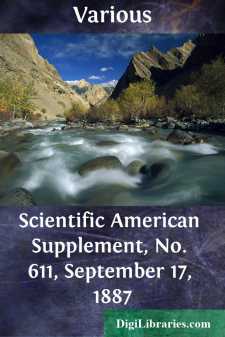Categories
- Antiques & Collectibles 13
- Architecture 36
- Art 48
- Bibles 22
- Biography & Autobiography 813
- Body, Mind & Spirit 142
- Business & Economics 28
- Children's Books 17
- Children's Fiction 14
- Computers 4
- Cooking 94
- Crafts & Hobbies 4
- Drama 346
- Education 46
- Family & Relationships 57
- Fiction 11829
- Games 19
- Gardening 17
- Health & Fitness 34
- History 1377
- House & Home 1
- Humor 147
- Juvenile Fiction 1873
- Juvenile Nonfiction 202
- Language Arts & Disciplines 88
- Law 16
- Literary Collections 686
- Literary Criticism 179
- Mathematics 13
- Medical 41
- Music 40
- Nature 179
- Non-Classifiable 1768
- Performing Arts 7
- Periodicals 1453
- Philosophy 64
- Photography 2
- Poetry 896
- Political Science 203
- Psychology 42
- Reference 154
- Religion 513
- Science 126
- Self-Help 84
- Social Science 81
- Sports & Recreation 34
- Study Aids 3
- Technology & Engineering 59
- Transportation 23
- Travel 463
- True Crime 29
Scientific American Supplement, No. 611, September 17, 1887
by: Various
Categories:
Description:
Excerpt
The inauguration of the statue of Philip Lebon, the inventor of lighting by gas, occurred on the 26th of June, at Chaumont, under the auspices of the Technical Gas Society of France. The statue, which we illustrate herewith, is due to the practiced chisel of the young sculptor Antide Pechine, who has perfectly understood his work, and has represented the inventor at the moment at which he observes a flame start from a glass balloon in which he had heated some sawdust. The attitude is graceful and the expression of the face is meditative and intelligent. The statue, which is ten feet in height, was exhibited at the last Salon. It was cast at the Barbedienne works.
It would be impossible to applaud too much the homage that has just been rendered to the inventor of gas lighting, for Philip Lebon, like so many other benefactors of humanity, has not by far the celebrity that ought to belong to him. When we study the documents that relate to his existence, when we follow the flashes of genius that darted through his brain, when we see the obstacles that he had to conquer, and when we thoroughly examine his great character and the lofty sentiments that animated him, we are seized with admiration for the humble worker who endowed his country with so great a benefit.
Lebon was born at Brachay on the 29th of May, 1767. At the age of twenty, he was admitted to the School of Bridges and Roads, where he soon distinguished himself by his ingenious and investigating turn of mind. His first labors were in connection with the steam engine, then in its infancy, and on April 18, 1792, the young engineer obtained a national award of $400 to continue the experiments that he had begun on the improvement of this apparatus.
It was at about the same epoch that Lebon was put upon the track of lighting by gas, during a sojourn at Brachay. He one day threw a handful of sawdust into a glass vial that he heated over a fire. He observed issuing from the bottle a dense smoke which suddenly caught fire and produced a beautiful luminous flame. The inventor understood the importance of the experiment that he had just performed, and resolved to work it further. He had just found that wood and other combustibles were, under the action of heat, capable of disengaging a gas fit for lighting and heating. He had seen that the gas which is disengaged from wood is accompanied with blackish vapors of an acrid and empyreumatic odor. In order that it might serve for the production of light, it was necessary to free it from these foreign products.
Lebon passed the vapor through a tube into a flask of water, which condensed the tarry and acid substances, and the gas escaped in a state of purity. This modest apparatus was the first image of the gas works; and it comprised the three essential parts thereof—the generating apparatus, the purifying apparatus, and the receiver for collecting the gas.
One year afterward, the inventor had seen Fourcroy, Prony, and the great scientists of his epoch. On the 28th of September, 1799, he took out a patent in which he gives a complete description of his thermo lamp, by means of which he produced a luminous gas, while at the same time manufacturing wood tar and pyroligneous or acetic acid. In this patent he mentions coal as proper to replace wood, and he explains his system with a visible emotion and singular ardor. In reading what he has written we are struck with that form of persuasion that does not permit of doubting that he foresaw the future in reserve for his system.
Unfortunately, Lebon could not devote all his time to his discovery. Being a government engineer, without money and fortune, he had to attend to his duties....












